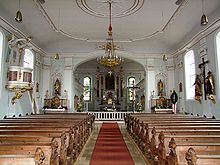Most Holy Trinity (Kronburg)
The Holy Trinity Church is a branch church in Kronburg near Memmingen in Upper Swabia . The branch church belongs to the parish of Illerbeuren in the Roman Catholic deanery Memmingen in the diocese of Augsburg .
location
The church is located west below the Kronburg Castle in the middle of the old village Kronburg on a plateau-like hill section of the castle hill.
history
The church was built in 1583 by a builder from the Palatinate Elector. The first restoration took place between 1698 and 1699. The interior of the church was redesigned in 1786, followed by further restorations in 1887, 1931 and 1978.
Building description
The church building, which consists of a single nave with a chancel in front, is structured on the outside by blind arches. On the east side there is a strong, square tower with an octagon and a curved dome. The open sign is in front of the main entrance on the west facade. The interior of the rectangular choir area is separated from the main nave by an archway. The separating arch protrudes far into the aisle, which means that two additional rooms can be walled in in the choir area. On these there are private chapels for the counts of Kronburg Castle, the rooms themselves are used as a sacristy and storage room. In the middle of the choir area is the high altar, which is flanked by two stained glass windows. The nave has a one-story west facade gallery. Both rooms have a pilaster structure and a flat barrel vault with rounded corners.
Furnishing
The entire interior of the church was redesigned in a classical style during the renovation in 1786. The main color chosen was white.
High altar
The high altar is designed as an altar structure. Only the altar table is made of wood. The superstructures merge into the rear wall, which is decorated with stucco. The altarpiece shows the Holy Trinity and was painted by Johann Friedrich Sichelbein .
Side altars
In front of the choir arch there are two side altars on the left and right, which were made around 1786. The marbled wooden altar structures in a slightly curved sarcophagus shape consist of a wooden table with a small structure. The antependia are decorated with gold decorations. The middle parts of the superstructure are tabernacle-shaped, with a crucifix as a crown. This is flanked by two silver-plated candlesticks. Vases with gilded lily flowers stand on the side plinths. The figure niches are embedded in the walls. The figures in the wall niches were probably made by the Überlingen master in the second half of the 18th century and belonged to the large wooden crucifix of a crucifixion group. The wall niches are bordered with a decorative belt made of stucco in alternating white and gold. A stucco cartouche with putti and flower hangings can be seen above the niches.
The north side altar is dedicated to the Virgin Mary. Above that, on a marble plinth in the figure niche, there is a statue of Our Lady. The figure, dressed in a red undergarment with a golden cloak with a blue inner fabric, holds a scepter in her right hand. In her left hand she holds a baby Jesus dressed in silver. Mary looks down on the baby Jesus. Her head is covered with a white headscarf and a gold crown. The baby Jesus raises his right hand to greet the Salvator, in the left he holds an orb. His head is surrounded by a halo. In the cartridge stands Mother of the Redeemer .
The southern side altar is dedicated to Saint Joseph. The figure of Joseph is dressed in a lime green robe with a golden cloak. His left hand is on his left breast and he is holding a lily in his right. The bearded face looks slightly down to the right. He has full dark brown hair. In the cartouche above the figural niche stands God is love .
pulpit
The wooden pulpit, created around 1768, is framed in white with gold decorations. The fillings are marbled. It has a volute console . At the bottom of the basket is a putto with an open book. In the book it says little child loves one another Joh. Ev. The sides are also adorned with gold stars. The putto itself is framed in white and sits on a wide, golden cloth that swings backwards along the pulpit. The sound cover has been artistically implemented as a ring-shaped, forward curved cornice. On his forehead is a golden dove with a halo as a sign of the Holy Spirit. On the left of the curved outer edge is a putto with a cross, which he holds up, on the right curved edge two putto heads are shown. The rear wall of the pulpit is designed as pilaster strips and drapery. Two plaques hang on the back wall. The Roman numerals I to X are carved in gold on these as symbols for the Ten Commandments.
Piece
The stucco presumably comes from Franz Xaver Feichtmayer .
See also
Web links
literature
- Tilmann Breuer: City and District of Memmingen . Ed .: Heinrich Kreisel and Adam Horn. Deutscher Kunstverlag, Munich 1959, p. 133, 134 .
Individual evidence
Coordinates: 47 ° 54 ′ 17.5 ″ N , 10 ° 9 ′ 21.4 ″ E



